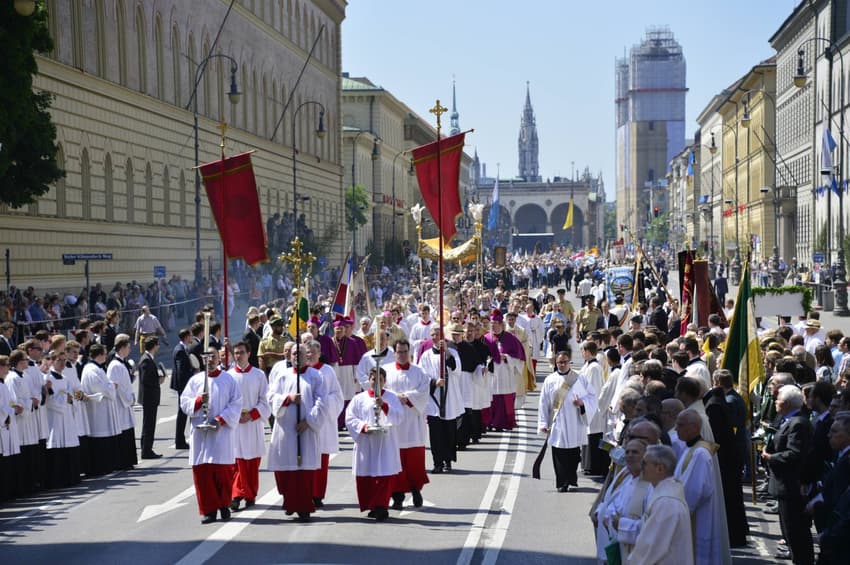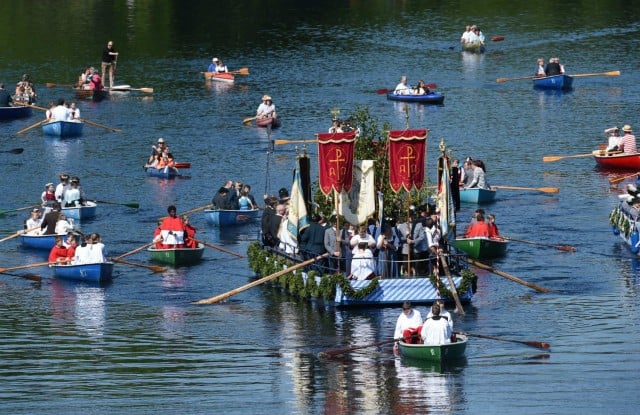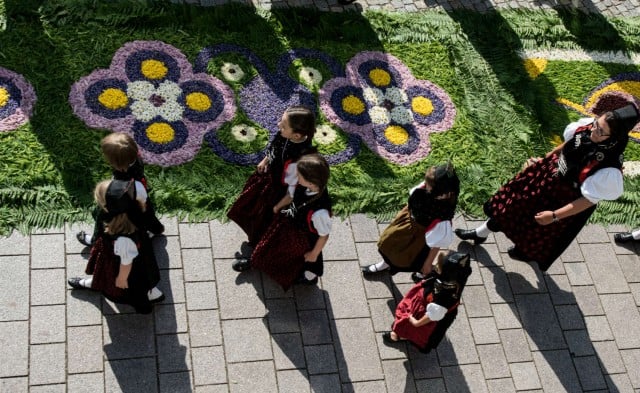Why south Germany blooms with religious bombast on Fronleichnam

Thursday is yet another public holiday in the Catholic states of southern and western Germany. The celebration of Fronleichnam (Corpus Christi) is one of the more obscure but colourful Catholic celebrations.
What is Fronleichnam?
The word comes from the Middle High German vronlicham meaning “the body of God.” In English the festival is known by the Latin name Corpus Christi, which also means body of Christ.
On Fronleichnam, Catholics celebrate the belief that Jesus remains with us in the flesh through the bread and wine consumed during communion.
Unlike Christmas, Easter and Whitsun, Fronleichnam isn’t specifically referenced in the Bible. But there is a close connection between the festival and the Last Supper, at which Jesus gave his disciples bread and wine. Catholics believe that Jesus created the sacrament of the Eucharist when he told his disciples that the bread “is my flesh” and the wine “is my blood.”
The first Fronleichnam procession was held in the year 1270.
Where is it celebrated?
If you are lucky enough to live in Bavaria, Baden-Württemberg, Hesse, Saarland, Rhineland-Palatinate or North Rhine-Westphalia, you have a holiday on Thursday because of Fronleichnam. If you live anywhere else, more fool you for picking a part of Germany where Martin Luther got the upper hand.
 A water based parade in Staffelsee, Bavaria. Photo:: DPA
A water based parade in Staffelsee, Bavaria. Photo:: DPA
When is it celebrated?
Fronleichnam is always celebrated on the second Thursday after Whitsun. It is really a sort of delayed celebration of the Last Supper which took place on Maundy Thursday. According to Dom Radio, the radio station of the Cologne Cathedral, celebrating the fest on Maundy Thursday wouldn’t befit the reflective nature of Easter.
Catholics in states that don’t have a public holiday have their processions on the following weekend.
How is it celebrated?
Differently in different places. In Fritzlar in north Hesse, the celebrations start on Wednesday night with the so-called Katzenkoppschießen. During this ceremony, the eight bells of the town cathedral are rung and a canon is fired, a ritual that is repeated three times.
In Cologne, there is a procession involving over 100 ships, while in Bamberg 18 men carry a huge cross through the town.
 A floral carpet in Hüfingen, Baden-Württemberg. Photo: DPA
A floral carpet in Hüfingen, Baden-Württemberg. Photo: DPA
Generally the fest is celebrated with processions in which believers carry an ornately decorated monstrance with a sacred Eucharist wafer through the streets.
The towns of Hüfingen and Mühlenbach are renowned for their carpets made of flowers, which decorate the route of the procession and stretch to 100 metres in length.
It is also common for flags to festoon the route of the procession, while processions often visit alters along the way.
The political dimension
According to Dom Radio, the processions have often had a subversive element. The extrovert and bombastic character was meant to show Protestants how great it is to be a Catholic. Luther, for his part, described the holiday as “the most damaging of all festivals.”
In the Nazi era, the festivals were also a form of passive resistance against the secular state rulers. And even today the parades are a way of saying that religion belongs in the public sphere as well as the private, Dom Radio writes.
Comments
See Also
What is Fronleichnam?
The word comes from the Middle High German vronlicham meaning “the body of God.” In English the festival is known by the Latin name Corpus Christi, which also means body of Christ.
On Fronleichnam, Catholics celebrate the belief that Jesus remains with us in the flesh through the bread and wine consumed during communion.
Unlike Christmas, Easter and Whitsun, Fronleichnam isn’t specifically referenced in the Bible. But there is a close connection between the festival and the Last Supper, at which Jesus gave his disciples bread and wine. Catholics believe that Jesus created the sacrament of the Eucharist when he told his disciples that the bread “is my flesh” and the wine “is my blood.”
The first Fronleichnam procession was held in the year 1270.
Where is it celebrated?
If you are lucky enough to live in Bavaria, Baden-Württemberg, Hesse, Saarland, Rhineland-Palatinate or North Rhine-Westphalia, you have a holiday on Thursday because of Fronleichnam. If you live anywhere else, more fool you for picking a part of Germany where Martin Luther got the upper hand.
 A water based parade in Staffelsee, Bavaria. Photo:: DPA
A water based parade in Staffelsee, Bavaria. Photo:: DPA
When is it celebrated?
Fronleichnam is always celebrated on the second Thursday after Whitsun. It is really a sort of delayed celebration of the Last Supper which took place on Maundy Thursday. According to Dom Radio, the radio station of the Cologne Cathedral, celebrating the fest on Maundy Thursday wouldn’t befit the reflective nature of Easter.
Catholics in states that don’t have a public holiday have their processions on the following weekend.
How is it celebrated?
Differently in different places. In Fritzlar in north Hesse, the celebrations start on Wednesday night with the so-called Katzenkoppschießen. During this ceremony, the eight bells of the town cathedral are rung and a canon is fired, a ritual that is repeated three times.
In Cologne, there is a procession involving over 100 ships, while in Bamberg 18 men carry a huge cross through the town.
 A floral carpet in Hüfingen, Baden-Württemberg. Photo: DPA
A floral carpet in Hüfingen, Baden-Württemberg. Photo: DPA
Generally the fest is celebrated with processions in which believers carry an ornately decorated monstrance with a sacred Eucharist wafer through the streets.
The towns of Hüfingen and Mühlenbach are renowned for their carpets made of flowers, which decorate the route of the procession and stretch to 100 metres in length.
It is also common for flags to festoon the route of the procession, while processions often visit alters along the way.
The political dimension
According to Dom Radio, the processions have often had a subversive element. The extrovert and bombastic character was meant to show Protestants how great it is to be a Catholic. Luther, for his part, described the holiday as “the most damaging of all festivals.”
In the Nazi era, the festivals were also a form of passive resistance against the secular state rulers. And even today the parades are a way of saying that religion belongs in the public sphere as well as the private, Dom Radio writes.
Join the conversation in our comments section below. Share your own views and experience and if you have a question or suggestion for our journalists then email us at [email protected].
Please keep comments civil, constructive and on topic – and make sure to read our terms of use before getting involved.
Please log in here to leave a comment.